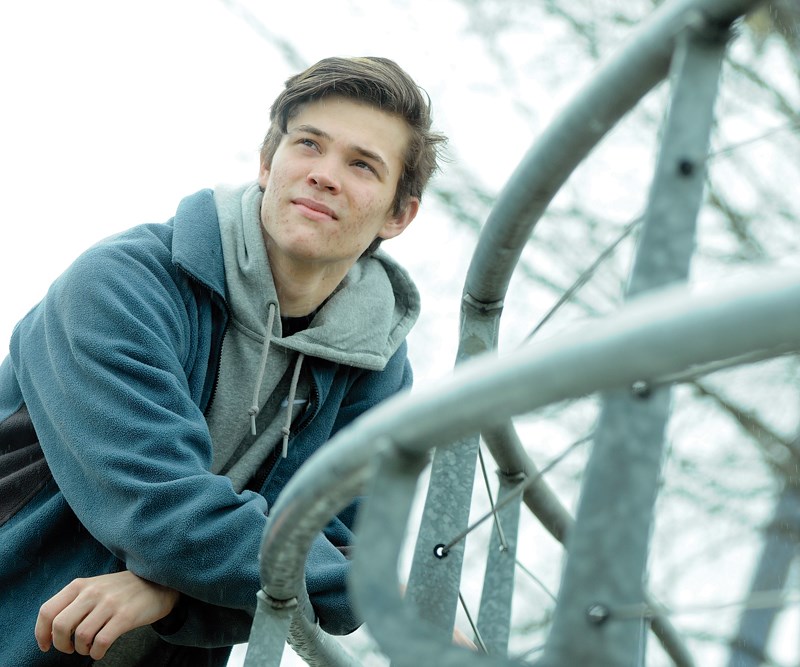Aidan Charles wants to fly.
This summer, the 16-year-old pilot plans to soar from Surrey to Sudbury to Sidney to St. Johns, N.L. and back again.
“It is a long flight. It will be dangerous, but I think I can pull it off,” he says.
Just months before his 17th birthday, the St. Thomas Aquinas flyboy divides his free time between a part-time job at Browns Social House and an airplane hangar where each turn of the wrench gets him closer to the clouds.
He’s hoping his 12-day flight across the country and back will raise $10,400 – about a dollar per kilometre – for Hope Air, a national charity that offers flights for low-income Canadians who have trouble accessing health care.
Charles, who has logged just over 80 hours of flying time, hasn’t flown farther afield than Powell River since earning his pilot’s licence in 2016, but he’s looking to change that. “With the licence I have I can go anywhere in Canada, so why not make the most of that?”
The North Van teen’s fascination with flying first manifested when a childhood trip to England was upstaged by the plane ride over the Atlantic, Charles recalls.
“That was the most exciting part,” he says.
His parents thought an introductory flying lesson might satisfy their son’s curiousity but it only served to fuel his passion, according to his father, John Charles.
“He came back and he loved it,” John says with a laugh.
The teen began formal flight training at 14 and flew his first solo flight at 15. But there was still no warning when he broached the idea of a cross-Canada journey.
“My reaction (was), ‘Holy cow, how is this going to work?’” John recalls.
“(My parents) weren’t really sure if I could pull it off so I really wanted to show them that it would be possible,” Charles says.
On his father’s advice, Charles did some legwork and eventually made the acquaintance of Arnold Klappe, the operator of King George Aviation in Surrey.
“He didn’t have an airplane,” Klappe explains. “Nobody was willing to give him one, as you can imagine.”
Klappe might not have helped but two considerations changed his mind: there was the possibility of some advertising, naturally, but Charles also showed evidence of a rare quality in teenagers: gumption.
“If you’ve got the chutzpah to stand up and say: ‘I want to do this,’ then let’s see what you’re made of,” says Klappe.
On weekends and some evenings, Charles treks to South Surrey to work on a “half-built” Rans S-6 Coyote. The work is payment for the adventure, Klappe explains.
While Charles has been fascinated with flying “as long as I can remember” this was the first time he cracked open the hood and found out how it all works.
“I’ve never really been one to work with tools,” he says.
Klappe laughs in agreement. “That might be a little obvious at times,” he says, noting that mechanical ignorance is common among the jet set.
“There’ll be commercial pilots that’ve never seen an engine, let alone know how to fix it.”
However, Charles is a quick study, and the work they’re doing on the ground should be invaluable in the air, says Klappe. “In the unlikely event that he does have an issue, he’ll know how to fix it.”
The monoplane has no autopilot function, leaving Charles an onerous task.
“It’s just going to be real hands-and-feet flying across the country,” he predicts.
Looking down on the world for between six and eight hours every day can be taxing for any pilot, Charles notes.
“Fatigue is a big one,” he says. “I definitely have to be aware of my limits, know when to call it a day even though I will be under pressure to complete it in a certain time frame.”
Making it past mountains, Prairie thunderstorms and Ontario smog may make it a tough trip, according to David McIntosh, chief flight instructor at Professional Flight Centre in Vancouver.
“You can get socked in if you’re trying to get through the mountains. It’s kind of like a maze with low-level cloud,” he says.
When empty, the Coyote weighs about 440 pounds. In general, lightweight planes can tax a pilot’s stomach, McIntosh noted.
“It’s like a leaf in the wind … as opposed to a brick in the wind,” he says. “Considering it’s a six-day trip, I hope he brings an airsick bag.”
Also, if he wants to avoid flying at night, Charles may find himself “racing the clock” to get to the airport by dusk.
Ultimately, McIntosh says he hopes Charles has enough instrument and mountain flying experience, and that, like all pilots should, he makes every choice with the highest regard for safety.
While there may have been a few moments where they wondered aloud if their son was making the wisest decision, John says he’s happy to support his son.
“He’s a man on a mission,” John says.
The trip – planned for June – is a fitting way to focus on the gulf between “home and health care” many rural Canadians face, according to Hope Air associate development manager Meredith Lilly.
While Charles still needs a few parts for the plane as well as enough cash to pay for fuel, food and lodging, he’s eager to get into the air.
“Driving a car, it’s something everybody does. When you learn to fly, it takes a certain kind of person, I think. You have to really be on top of what you’re doing,” he says. “It’s a feeling of freedom.”
Learn more at crosscanadasolo.com.



